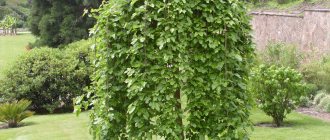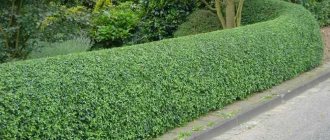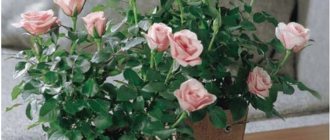The bean plant, also called laburnum, belongs to the legume family. This genus is represented by low-growing trees or deciduous rather tall shrubs. This genus includes a pair of species and one interspecific hybrid. Under natural conditions, laburnum is found in the Caucasus, Southern and Central Europe, and also in Asia.
During flowering, this plant looks very impressive, which is why it is very popular among gardeners. People also call it “golden rain bean,” and this is due to the fact that the flowering bush is decorated with long yellow inflorescences hanging in a cascade.
Growing beans in your garden plot is not difficult, but only if you find the most suitable site for it and care for it properly.
Features of the bean plant
The height of the bean tree depends on what species and variety it belongs to, and can vary from 3 to 7 meters. Its crown is spreading with a diameter of 3 to 4 meters. It consists of flexible stems that can be straight or weeping. Before the plant blooms, trifoliate, long-petiolate, oval-shaped leaf plates grow on it. There is slight pubescence on the underside of the foliage, as well as on the shoots.
This plant blooms in the last days of April and fades in June. The small, deep yellow flowers have a shape similar to butterflies. They are part of lush brushes that are 0.2–0.5 m long. A large number of inflorescences are formed on one bush. In place of withered flowers, fruits are formed, which are narrow and dry pods, reaching 50–60 mm in length. They fully ripen in September. When planting laburnum in a region with a cold climate, you need to take into account that in such conditions it will bloom more sparingly and for a short time.
general description
The homeland of bean broom is Southern Europe, but now it is also grown in southern Europe, Russia, Ukraine, and the Balkans. As a representative of greenhouses and winter gardens, he has long conquered the whole world.
In adulthood, it can be represented in two forms: a tree or a shrub, reaching 7 m in height. It is a deciduous crop. The trunk and branches are covered with light speckled bark. The crown of the bean tree is oval, with weeping shoots. The appearance of foliage begins in April, when the entire tree or shrub is quickly covered with trifoliate green leaves. The underside of the leaf blades is covered with fluffy light gray hair.
Flowering begins in early or mid-May depending on weather conditions. First, numerous flowering shoots of drooping shape appear, reaching 20-25 cm, and brush-shaped inflorescences bloom on them. Throughout the period of abundant flowering, a sweet aroma remains around the bean tree, attracting a large number of pollinating insects. This continues for two to three weeks, after which the petals fall and thickly cover the ground under the ornamental shrub.
After pollination, in place of the flowers, fruits remain in the form of beans, which turn brown when ripe. The beans are filled with small seeds 3 mm in length.
Planting beans in open ground
Selecting a location
A suitable place on the site for the bean plant should be well-lit and warm, and also have reliable protection from strong gusts of wind. Please note that in the shade the tree blooms more sparingly, and young plants may suffer from frost in strong winds in winter. The soil for such a plant needs well-drained, moderately moist and nutritious soil with an alkaline pH. However, it grows quite well in acidic, sandy, poor soil.
Choose the place for planting the bean tree with special care, since it will not be possible to replant it in the future. The fact is that it has a massive root system, which is simply impossible not to damage during transplantation.
Landing Features
If the seedling has a closed root system, then it can be planted in the ground from spring to autumn. Planting of plants with an open root system is carried out either in the middle of autumn or in early spring. If the soil in the area is clayey, then a good drainage layer should be made at the bottom of the planting hole; for this you can use large expanded clay or pieces of brick. The soil with which the hole will be filled must be mixed with sand.
Dip the roots of the seedling into the hole and cover them with soil mixed with compost. After the bush is planted, compact the surface of the trunk circle and water it well. To significantly slow down the evaporation of moisture from the soil and the growth of weeds, the surface of the tree trunk circle is covered with a layer of mulch (bark or compost). If the tree is single-trunked or on a trunk, then until it gets stronger and gains strength, it is tied to a support.
Golden shower - propagation by bean seeds - stratification and planting
How to buy
Bean plants are planted exclusively in the spring; therefore, seedlings should be purchased at the very beginning of spring, before the first leaves appear. The plant must have a good earthen ball or be planted in a pot.
When choosing planting material, first of all, ask what country the seedlings were brought from.
In the Moscow region, plants that arrived from Northern Germany, Poland, and the Czech Republic take root well and overwinter; seedlings grown here are even better. If the country of origin of the planting material is Holland, Italy or Belgium, there is an almost 100% chance of the plant dying in the first severe frosts.
Bobovnik care
Watering
Bobovnik is drought-resistant. However, while the plant is young, it will require regular watering once every 7 days. If there is a long, hot, dry period, then the frequency of watering the young tree needs to be increased. A large mature tree is watered only if there has been no rain for a long time.
Wintering
This crop is classified as winter-hardy plants. However, until the bean tree is two or three years old, it may suffer from cold in winter, especially if the frost is very severe. If you grow a Waterer hybrid, then be sure to cover it with agrofibre for the winter. Since the crown of this shrub has a sloping shape, snow may accumulate on it, which often leads to injury to the stems. To avoid this, you need to shake off snow from the plant if necessary.
Trimming
This plant tolerates pruning very hard. After it, it weakens greatly and takes a very long time to recover. If you need to cut out dried or injured branches, then do this pruning in early spring. If you need to cut a healthy branch, be sure to protect the cut site from infection; to do this, coat it with garden varnish.
After flowering, a large number of fruits can form on the tree, which take a lot of energy from the plant. Therefore, experienced gardeners recommend cutting them off immediately after formation.
Fertilizer
Feed beans in the spring. To do this, dig up the soil around the tree trunk, adding compost to it.
Why doesn't the bean flower bloom? | toNature.Info
Reproduction methods
Growing from seeds
Bobovnik reproduces very well by self-sowing. However, if such a need arises, then you can grow seedlings from seeds yourself. In order for the seeds to germinate, they must be stratified by cold. There are 2 options:
- Sow seeds into the garden in late fall. During the winter they will undergo natural stratification. Before sowing, it is recommended to place the seed material in hot water for a while so that the dense shell becomes softer.
- The seeds can be mixed with sand and placed on the refrigerator shelf, where they will be stored at a temperature of 0 to 1 degree until spring. With the onset of warmth, sow stratified seeds in open ground.
After the plants emerging from the seeds have grown and become stronger, they can be transplanted to a permanent place. The bushes are taken together with a lump of earth. Such a plant will bloom only in the third to fifth year from the moment the seedling appears.
Cuttings
Bobovnik also propagates well by cuttings. To do this, you will need to prepare non-lignified cuttings in June. Please note that to propagate the Waterera hybrid, lignified cuttings are used, which are cut in March. They should reach 15 to 20 centimeters in length. Remove all lower leaf blades from the sections, and treat the cut area with a root growth stimulating agent. Plant the cuttings for rooting in a mixture of sand and peat.
When the cuttings are planted, they are carefully watered and covered with a transparent cap (glass jar, bag, etc.) on top. Remember to keep the soil mixture moist at all times. Once the cutting has taken root, wait 30 days and transplant it into the garden. During the first three years, the trunk circle of a young plant must be covered with a thick layer of mulch (spruce branches or fallen leaves) in late autumn.
How to propagate by layering
This method is only suitable for those plants that have side shoots. For a low-growing shoot, an incision is made on the underside (facing the soil surface) closer to the base. Bend the stem and place it in a shallow (10 to 20 mm) trench with the cut down. Fix it in this position and cover it with nutrient soil. A year later, if the cuttings begin to actively grow, they are separated from the parent bush and planted in a permanent place.
Bobovnik in landscape design
Bobovnik looks great next to flowering and decorative deciduous shrubs (for example, barberry, buddleia, spirea, azalea, etc.), as well as with not very tall coniferous crops. It can also be used for single planting. This crop is also suitable for decorating gazebos, pergolas and trellises, as it has drooping flexible stems.
Most often in the garden, laburnum is used to create canopies, arches and tunnels. At the top of the tunnel, the stems are arranged horizontally, which stimulates lush flowering of the bean. This plant also looks very impressive next to wisteria. Phlox, hydrangea, roses, etc. look great against the background of drooping bean stems.
Diseases and pests
Bobovnik is highly resistant to diseases. However, due to increased air humidity or due to stagnation of liquid in the soil, a fungal disease may develop on the bush. The affected bush develops gray round spots on the foliage, which over time change their color to brown. The diseased bush is sprayed with an antifungal agent as soon as possible (for example, Topsin M 500 SC). At the end of the autumn leaf fall, all fallen leaves are destroyed.
If the spring turns out to be damp, then the bean tree may be affected by gray mold, due to which its inflorescences and young shoots turn brown and die. Cut off all diseased parts of the bush and spray it with Signum 33 WG solution. After a week and a half, re-treatment is carried out.
Most often, aphids and spider mites settle on such a plant, due to which a mosaic discoloration of the foliage is observed.
Virulence
Please note that all parts of the bean tree contain poison, its concentration is especially high in the seeds. And it contains the alkaloid cytosine and other quinolizidine alkaloids. If they get inside the human body, they can cause severe poisoning. A fatal outcome for a person is possible if he eats several dozen seeds. Pets may die from fewer seeds. After 15–60 min. after the bean seeds enter the body, the first signs of poisoning appear, namely: convulsions, burning in the throat and mouth, severe nausea and vomiting.
Diseases
The most important feature is that golden rain is very poisonous. It is advisable not to plant this tree or bush in gardens where children have free access. Two beans eaten by a careless child are enough to cause death.
When doing gardening work that involves contact with plants, use rubber gloves.
Due to the extreme toxicity of all parts of the bean plant, all types of pests do not touch it, and it is almost not susceptible to diseases. The only disease characteristic of this species is powdery mildew. If not stopped in time, this disease leads to complete loss of leaves. To protect against it, the leaves and branches of the tree are treated with fungicides.
All of the above rules are mandatory for gardeners who want to grow an ornamental leafy and beautifully flowering plant - bean - in their garden. It is enough to study them carefully and strictly adhere to them so that planting and caring for this southern plant in the Moscow region will be crowned with success. Have a beautiful garden!
Types of beans
Bobovnik anagyrofolia or common
This plant is native to Eastern France, the Mediterranean and Central Europe. This species is the most widespread in culture. It is a low tree (5 to 6 meters) or a vigorous shrub with straight stems. The shape of the dark green leaf blades is somewhat similar to clover. There is pubescence on their surface. Flowering is observed in May–June. Long (from 15 to 25 centimeters) inflorescences consist of odorless flowers of a golden yellow hue. When growing this species, it should be taken into account that it reproduces well by self-sowing, and young plants grow very quickly.
The best varieties:
- " Aureum ". In spring, the foliage of this plant is colored a rich golden-yellow hue. After some time, its color changes to yellowish-green.
- " Pendulum ". Its drooping long stems are highly decorative.
Alpine bean (Laburnum alpinum)
The length of the hanging inflorescences of this species can vary from 0.3 to 0.4 m; they are very fragrant. On shoots and foliage, pubescence is completely absent. Flowering of this species begins approximately half a month later, when compared with anagyrofolia.
The best varieties:
- " Pendula ". A small tree on a trunk is decorated with very spectacular, sparse and long stems, hanging almost to the ground.
- " Sunspire ". This is a dwarf group. It is extremely rare to find on sale.
Waterer's bean (Laburnum x watereri)
This plant is an interspecific hybrid. This is a multi-stemmed low tree with drooping upper stems. Such a bean plant can reach its maximum height only at the age of 20 to 50 years. Its dense inflorescences can reach about 0.4 m in length and consist of fragrant flowers. This hybrid has the “Vossii” variety, which has the most lush and long (about half a meter) inflorescences. This species has low frost resistance and needs shelter.
There is also an intergeneric hybrid with broom, which is called Laburnocytisus adamii, or pink bean. It can be found in some nurseries. At the same time, pink and yellow inflorescences can bloom on the bush, which can acquire purple and red tints.
Yellow wisteria? No! This is bobovnik or golden shower. There are NO yellow wisterias!
Varieties
During the period from mid-May to mid-June, when the bean flowers bloom, the illusion is created that golden rain is pouring from the green branches. This is what people call this plant. A tree that reaches a height of up to 3 m in the Moscow region, with dark green leaves and bright yellow racemes 30 - 50 cm long - common bean or anagyrofolia. The species is widely used for landscaping gardens. Its varieties are distinguished by the color of their flowers.
In the gardens there are bushes completely strewn with soft pink flowers - this is the pink bean plant. Its flowering period is short, only 2 weeks, but the bushes remain decorative throughout the summer thanks to immunity to almost all types of diseases.
When drawing up a landscape gardening plan, take into account that the pink bean tree goes well with conifers, heathers, and other dark green bushes and trees.
A favorite option for hedges is garden red bean. This is a low bush (up to 0.5 m), blooming with red or bright pink flowers. A native of Switzerland and Germany, the Golden Rain bean is the most frost-resistant species. Its peculiarity is elongated light green leaves and bright yellow flower clusters, reaching a length of 0.5 m. Alpine bean is a tall (up to 10 m) tree with a dome-shaped crown. Differences between this species and anagyrofolia:
- higher frost resistance;
- small pale yellow, odorless flowers collected in brushes;
- light green foliage;
- time of the beginning of flowering (end of June).
The most decorative species is the Waterera bean, bred as a hybrid of alpine and anagyrofolia species.
The branches of a low (about 1 m) shrub are covered with dark green leaves. Velvet brushes of rich yellow color exude an unusually pleasant sweet aroma. Frosts near Moscow are contraindicated for this delicate plant; it is possible to grow the species in winter gardens.











